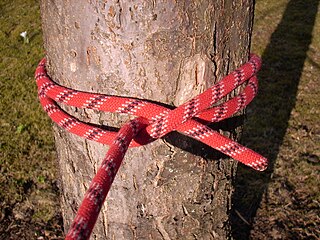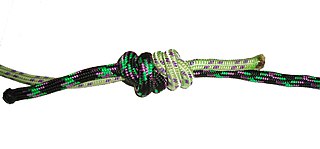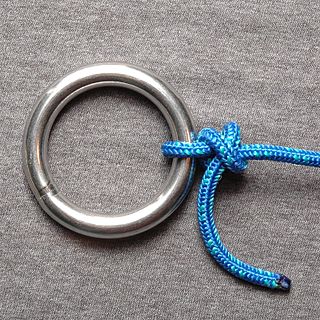 W
WThe Albright special or Albright knot is a bend used in angling. It is a strong knot used to tie two different diameters of line together, for instance to tie monofilament to braid. The Albright is relatively smooth and passes through guides when required. Some anglers coat the knot with a rubber based cement to make it even smoother and more secure.
 W
WThe anchor bend is a knot used for attaching a rope to a ring or similar termination. The name is a misnomer, as it is technically not a bend, but a hitch.
 W
WAn angler's loop, otherwise known as a perfection loop, is a type of knot which forms a fixed loop. Useful for fine or slippery line, it is one of the few loop knots which holds well in bungee cord. It is quite secure, but it jams badly and is not suitable if the knot will need to be untied.
 W
WA beer knot is a bend used to join tubular webbing. Its most common application is in constructing slings used in rock climbing. Compared with the water knot, it has the advantages of a higher strength, smaller profile, and a cleaner appearance due to the lack of free-hanging tails. However, the beer knot can be more difficult to tie than the water knot, and one of the tails is hidden from view, making safety checks for adequate tail length more difficult.
 W
WThe buntline hitch is a knot used for attaching a rope to an object. It is formed by passing the working end around an object, then making a clove hitch around the rope's standing part and taking care that the turns of the clove hitch progress towards the object rather than away from it. Secure and easily tied, the buntline hitch will jam when subjected to extreme loads. Given the knot's propensity to jam, it is often made in slipped form.The buntline hitch, when bent to a yard, makes a more secure knot than two half hitches, but is more liable to jam. It differs from two half hitches in that the second half hitch is inside instead of outside the first one.
 W
WThe clove hitch is a type of knot. Along with the bowline and the sheet bend, it is often considered one of the most important knots. A clove hitch is two successive half-hitches around an object. It is most effectively used as a crossing knot. It can be used as a binding knot, but is not particularly secure in that role. A clove hitch made around the rope's own standing part is known as either two half-hitches or buntline hitch, depending on whether the turns of the clove hitch progress away from or towards the hitched object.Although the name clove hitch is given by Falconer in his Dictionary of 1769, the knot is much older, having been tied in ratlines at least as early as the first quarter of the sixteenth century. This is shown in early sculpture and paintings. A round turn is taken with the ratline and then a hitch is added below. The forward end is always the first to be made fast.The difference between two half hitches and the clove hitch is that the former, after a single turn around a spar, is made fast around its own standing part, while the latter is tied directly around the spar.
 W
WThe constrictor knot is one of the most effective binding knots. Simple and secure, it is a harsh knot that can be difficult or impossible to untie once tightened. It is made similarly to a clove hitch but with one end passed under the other, forming an overhand knot under a riding turn. The double constrictor knot is an even more robust variation that features two riding turns.
 W
WThe corned beef knot is a binding knot usually made in small line or string. It gains its name by often being used for binding the meat of the same name while it is being cooked. Since corned beef shrinks during cooking, the knot needs to be tightened several times during the process.
 W
WThe double fisherman's knot or grapevine knot is a bend. This knot and the triple fisherman's knot are the variations used most often in climbing, arboriculture, and search and rescue. The knot is formed by tying a double overhand knot, in its strangle knot form, with each end around the opposite line's standing part.
 W
WThe double overhand noose is a very secure hitch knot. It might be used by cavers and canyoneers to bind a cow tail or a foot loop to a carabiner.
 W
WThe figure-eight knot or figure-of-eight knot is a type of stopper knot. It is very important in both sailing and rock climbing as a method of stopping ropes from running out of retaining devices. Like the overhand knot, which will jam under strain, often requiring the rope to be cut, the figure-of-eight will also jam, but is usually more easily undone than the overhand knot.The figure-eight or figure-of-eight knot is also called the Flemish knot. The name figure-of-eight knot appears in Lever's Sheet Anchor; or, a Key to Rigging. The word "of" is nowadays usually omitted. The knot is the sailor's common single-strand stopper knot and is tied in the ends of tackle falls and running rigging, unless the latter is fitted with monkey's tails. It is used about ship wherever a temporary stopper knot is required. The figure-eight is much easier to untie than the overhand, it does not have the same tendency to jam and so injure the fiber, and is larger, stronger, and equally secure.
 W
WFigure-eight loop is a type of knot created by a loop on the bight. It is used in climbing and caving where rope strains are light to moderate and for decorative purposes.The Flemish loop or figure-eight loop is perhaps stronger than the loop knot. Neither of these knots is used at sea, as they are hard to untie. In hooking a tackle to any of the loops, if the loop is long enough it is better to arrange the rope as a cat's paw.
 W
WThe fisherman's knot is a bend with a symmetrical structure consisting of two overhand knots, each tied around the standing part of the other. Other names for the fisherman's knot include: angler's knot, English knot, halibut knot, waterman's knot.
 W
WThe lobster buoy hitch is similar to the buntline hitch, but made with a cow hitch around the standing part rather than a clove hitch.
 W
WThe offset overhand bend is a knot used to join two ropes together. The offset overhand bend is formed by holding two rope ends next to each other and tying an overhand knot in them as if they were a single line. Due to its common use in several fields, this bend has become known by many names, such as thumb knot, openhand knot, one-sided overhand knot or flat overhand bend (FOB), though the terms "one-sided" and "flat" are considered incorrect.
 W
WThe overhand loop is a simple knot which forms a fixed loop in a rope. Made by tying an overhand knot in the bight, it can be tied anywhere along a rope. The knot can be used for attaching clips, hooks, other rope, etc., but has the disadvantage that it is likely to jam tight when the rope has been pulled and the knot may need to be cut off. It also has some uses in kite-flying, though other knots may be better. It is commonly disapproved by the Boy Scouts because of its tendency to be misused as an alternative to the bowline.
 W
WThe packer's knot is a binding knot which is easily pulled taut and quickly locked in position. It is most often made in small line or string, such as that used for hand baling, parcel tying, and binding roasts. This latter use, and its general form, make it a member of a class of similar knots known as butcher's knots.
 W
WThe reef knot, or square knot, is an ancient and simple binding knot used to secure a rope or line around an object. It is sometimes also referred to as a Hercules knot. The knot is formed by tying a left-handed overhand knot and then a right-handed overhand knot, or vice versa. A common mnemonic for this procedure is "right over left; left over right", which is often appended with the rhyming suffix "... makes a knot both tidy and tight". Two consecutive overhands of the same handedness will make a granny knot. The working ends of the reef knot must emerge both at the top or both at the bottom, otherwise a thief knot results.The reef knot or square knot consists of two half knots, one left and one right, one being tied on top of the other, and either being tied first...The reef knot is unique in that it may be tied and tightened with both ends. It is universally used for parcels, rolls and bundles. At sea it is always employed in reefing and furling sails and stopping clothes for drying. But under no circumstances should it ever be tied as a bend, for if tied with two ends of unequal size, or if one end is stiffer or smoother than the other, the knot is almost bound to spill. Except for its true purpose of binding it is a knot to be shunned.
 W
WThe transom knot is a simple lashing knot used to secure two linear objects, such as spars, at right angles to each other.
 W
WThe triple fisherman's knot is a bend knot, used to join two ends of rope together. It is an extension of the double fisherman's knot and is recommended for tying slippery, stiff ultra-high-molecular-weight polyethylene (UHMWPE) and aramid cored ropes.